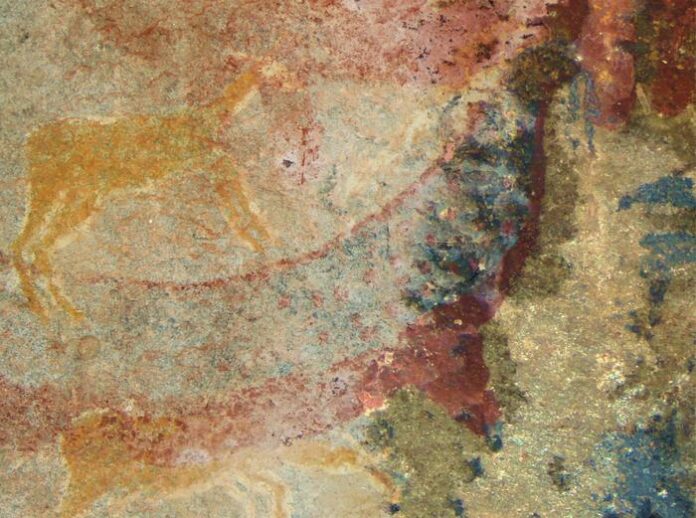Artists take inspiration from many sources. For the San people of South Africa, the spark that inspired some of their rock paintings may have come from fossils of creatures that went extinct more than 200 million years ago.
A study in PLOS ONE says that not only did the San draw on bones of dicynodonts — large animals with downward-turning tusks that roamed the Earth before dinosaurs — but that they beat Western paleontologists to the punch.
The “winged serpent” panel depicts a creature with tusks akin to the dicynodont. That painting dates to 1835 at the latest — meaning that the San were familiar with dicynodont fossils at least 10 years before paleontologist Richard Owen identified and named the species in 1845.
Paintings of Dicynodont Fossils
The San probably knew about the dicynodonts long before that, though, because their mythology includes descriptions of the creatures. Tying dicynodont fossils to both San myths and art shifts the perspective of the history of science, says Julien Benoit, a paleontologist from the University of the Witwatersrand in Johannesburg.
“The focus is usually put on the Western scientists who pioneered the field, but let’s not forget that other cultures were also finding fossils and tried to interpret them given their own belief system,” he says.
The parallels in the drawing to the dicynodont fossils are striking.
“The head is the main give away, as the tusks are highly diagnostic of dicynodonts,” says Benoit. “No other animal has such downward pointing tusks.”
Read More: Why Did Our Paleolithic Ancestors Paint Cave Art?
Fossils and Cave Art in the Karoo Basin
Similarities between the painting and the fossils persist beyond the head and the tusk. The pictured winged serpent’s body possesses a “strange banana-like flexure” akin to the pose of many fossils, likely caused when back muscles contract following death, says Benoit.
The painting also portrays the mythological creature as spotted, resembling mummified dicynodont skin found in the area.
That area, the Karoo Basin, is famous for abundant well-preserved fossils — including dicynodonts. These fossils are relatively easy to find, due to the fast-eroding ground in which they are buried.
Read More: 44,000-Year-Old Cave Art Shows A Hunt Filled With Fantastical Creatures
Indigenous Rock Paintings in North America and Africa
This isn’t the only example of the San showing an interest in fossils.
“We know the San discovered fossils because at the Bolahla rock shelter, in Lesotho, a dinosaur phalanx was discovered in archaeological context,” says Benoit. “This dinosaur bone was found, collected and transported by the San all the way to the shelter. Although we don’t know why they did it, this proves that they discovered fossils.”
In Lesotho, at Mokhali cave, there is also a rock painting that appears to picture a dinosaur footprint. There are other examples of indigenous paleontology, primarily in North America. Africa has been an overlooked area in this field, says Benoit. This example is especially robust because it ties both mythology and art to fossils.
“This is a smoking gun of the deep roots of indigenous paleontology in southern Africa,” says Benoit.
Read More: 5 of the World’s Most Fascinating Cave Paintings
Article Sources
Our writers at Discovermagazine.com use peer-reviewed studies and high-quality sources for our articles, and our editors review for scientific accuracy and editorial standards. Review the sources used below for this article:
Before joining Discover Magazine, Paul spent over 20 years as a science journalist, specializing in U.S. life science policy and global scientific career issues. He began his career in newspapers, but switched to scientific magazines. His work has appeared in publications including Science News, Science, Nature, and Scientific American.
Source : Discovermagazine







